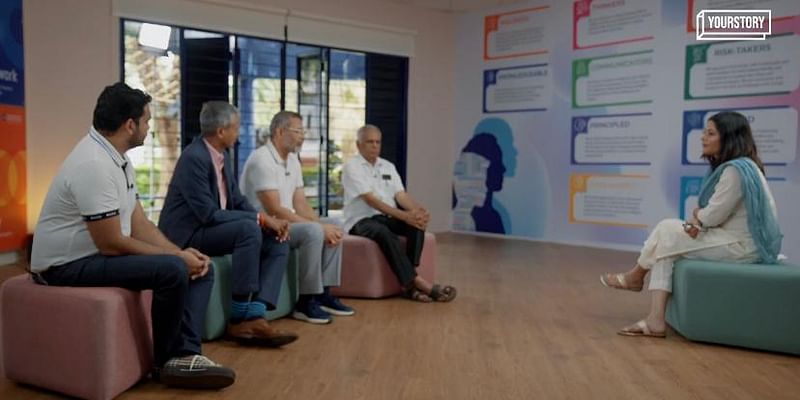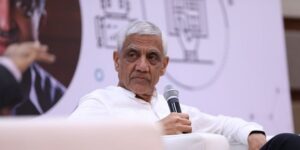
The world of education is undergoing a sweeping transformation where traditional models of teaching and learning are giving way to innovative approaches that prioritise personalisation, accessibility, and cutting-edge technology.
In a recent development, Kyndryl and USDC have joined hands to provide a unique, cloud-based ‘University-in-a-Box’ solution that will streamline third-party integrations, regulatory compliance, accreditation, audit support, and scalability to higher education institutions. USDC will offer the solution as a platform-as-a-service to universities, including JAIN University, which plans to enroll 100,000 learners for its online courses by 2025.
Shradha Sharma, Founder and CEO, YourStory, sat down with four eminent figures in the field of education and technology: Dr S Sadagopan, Founder and former Director of IIIT-B and Chief Strategic Advisor at JAIN Group of Institutions; Chenraj Roychand, Chancellor of JAIN University; Lingaraju Sawkar, President of Kyndryl India; and Tom M Joseph, Director of New Initiatives at JAIN University and Co-founder, USDC. Their conversation revolved around the evolving landscape of education, the impact of technology, and the vision for a more accessible and personalised educational experience.
Balancing synchronous and asynchronous learning
Dr S Sadagopan began the discussion by highlighting the significant changes and milestones in Indian education. He noted that India has crossed a new milestone with 40 million learners in higher education, with an increasing percentage of female students. While acknowledging that there have been dropouts, he talked about the resilient efforts of teachers, particularly during the COVID-19 pandemic, where many adapted to deliver education in challenging circumstances.
Dr Sadagopan underlined the need for a balanced approach to education, combining synchronous and asynchronous learning. “Synchronous teaching is best suited for those with a gift for communication, adept at connecting dots and, in a word, inspiring. While synchronous sessions are ideal for such discussions, information dissemination, involving copious facts and figures, may be more effectively delivered through asynchronous methods.
“Notably, students find it impractical to consume the entirety of a 45-hour video course, typically spread across 15 weeks. They advocate for a more flexible, personalised approach within the confines of a semester, allowing for variations in course duration. This flexibility addresses potential disruptions that might otherwise result in lost learning opportunities,” he said.
He shared his vision of personalised and individualised instruction for all 40 million students, facilitated by technology, creating innovation at scale. This, he believed, could be achieved through JAIN University’s initiative with USDC, supported by partners like Kyndryl. Achieving the right balance in content, delivery, and personalisation is the key.
Education meets experience
Roychand underscored the pivotal role of technology as an enabler, echoing Bill Gates’ sentiments. However, he said true quality education hinges on human connections and shared experiences, even if it means sacrificing scale.
The JAIN University campus in Bengaluru spans 300 acres, designed to encompass sports, natural spaces, and conducive learning environments. Within this locale, an ‘opportunity school’ has been established, catering to 2,000 children from 400 nearby villages, offering free education. Over two decades, this initiative has evolved, currently benefiting 800 students who have been relocated to other villages.
Roychand categorised individuals into three groups: the dreamers and risk-takers, representing 3%; the intellectual force making up 22%; and the skilled workforce, constituting 75%. His campus embodies a holistic approach, fostering sports, academic engagement, and leadership development.
The chancellor spoke about a harmonious integration of online and offline education, leveraging digitisation, augmented reality, and virtual reality to create a well-rounded learning experience through simulations, projects, and activity-based initiatives. Post-COVID, this integrated approach is crucial and has the potential to revolutionise education, he said.
Building a ‘University-in-a-Box’ for global impact
For Kyndryl, overseeing crucial infrastructure and services on a global scale has been a significant endeavour, Sawkar shared.
“As we expanded our operations in India and worldwide, we recognised the profound impact that education could have on society. We were always on the lookout for a partner with whom we could connect at a value level, but more importantly, who had the vision of scale. We could bring in the technology capability, but someone who could envision beyond the boundary of what education could do and transform,” he said.
In the JAIN group, alongside Dr Sadagopan, Roychand, and Joseph, Kyndryl discovered an ideal collaboration. Here, it could explore the full scope of what advanced technology could achieve and embrace the limitless possibilities within education.
Sawkar recognised the intricacies of the regulated education industry, requiring adherence to specific guidelines. He also acknowledged the continuous evolution within the education sector, which required continuous adaptability to new focus areas.
Keeping all these considerations in mind, Kyndryl developed a platform collaboratively. This platform was tailored for the JAIN Group’s needs and envisioned its deployment in various locations globally.
Sawkar likened it to a portable “university-in-a-box,” capable of being transported to multiple destinations and adjusted, according to different scales of operation. This adaptable framework, he said, held great promise for achieving their goals.
Redefining the learning experience
Joseph, the co-founder of USDC, talked about how his two-year-old venture collaborates with universities to establish digital infrastructure. Kyndryl, their new partner, has joined in this effort. Together, they also create content with a focus on personalisation and customisation.
He highlighted that modern learners act as consumers, actively choosing what and how they want to learn. He spoke about how replicating the traditional classroom experience in the online space is not entirely feasible. However, they aim to provide an exceptional online learning experience by leveraging advanced technology and cutting-edge curriculum. He stressed the significance of being relevant in the rapidly changing landscape of technology and ensuring that their actions reflect this relevance.
The collaborative efforts of JAIN University, Kyndryl, and dedicated educators have ushered in a new era of education that has redefined the boundaries of learning. By embracing the challenges of a rapidly evolving educational landscape, they have not only empowered millions of learners but also set a powerful precedent for the future of education worldwide.
For detailed insights, watch the video.
<div class="externalHtml embed" contenteditable="false" data-val="
“>










